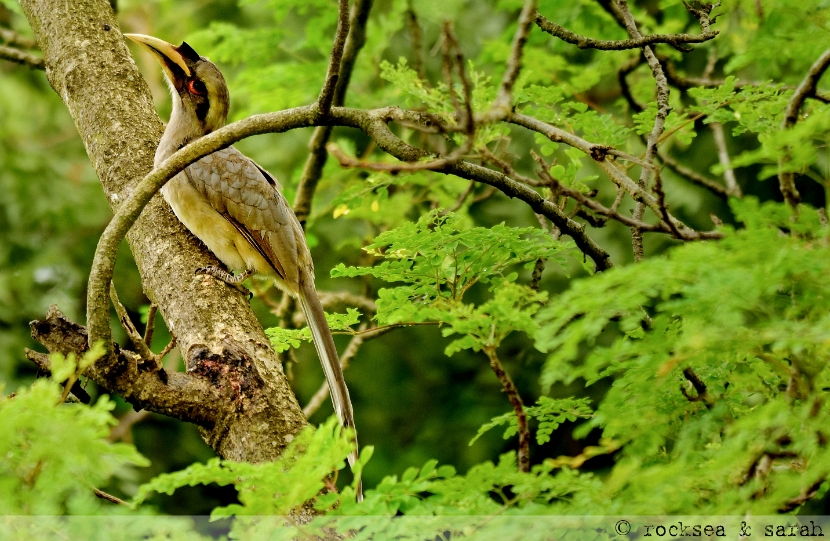Indian Grey Hornbill—the seed dispersers
There are about 54 species of hornbills in the world, out of which 9 occur in India. The hornbill pictured here is the Indian Grey Hornbill, which is common across the Indian subcontinent, except the wettest (Western Ghats and northeast) and the driest (northwest) parts of the country.

Breeding/Nesting
Hornbills have unique breeding habits, where the female confines herself into a nest cavity in a tree, with only a narrow opening through which the male shares the food throughout the nesting period. For the Indian grey hornbills, the total nesting period is about 87 days, where the female is confined to the nest cavity for an average of 76 days. Most of the grey hornbill nests are in hollows of the Mahagony tree family, located nearby riverine habitats. Deforestation, agriculture and other developmental activities have restricted the range of many species like these hornbills.
Grey hornbills as seed dispersers
Hornbills play a key role in seed dissemination, germination and regeneration of trees. This is because they are mainly frugivores (fruit consuming) and can break up/swallow large fruits, and regurgitate the seeds without damaging, making them the perfect dispersers. Since they travel long distances in search of fruits, they are capable of moving these seeds to distant locations.
Grey hornbills are effective seed dispersers for trees such as Premna tomentosa (a teak like tree), Putranjiva, Fern trees and even Sandalwood trees! Many of these are medicinally and commercially valuable trees but they generate very few seeds and propagation depends on birds like these hornbills.
Mid-air play and fight
Like many other hornbills, the grey hornbill has a long curved bill, which has a casque (helmet) on the top. The male hornbills engage in midair clashes where they jar against each other’s casques to establish their dominance and as part of their social play. This behaviour is known as aerial jousting.
Species: Ocyceros birostris
English: Indian Grey Hornbill
Location: IITM colony, Pune, Maharashtra
Date: 30 Jul 2016
Reference:
1. Santhoshkumar, E., & Balasubramanian, P. (2010). Breeding behaviour and nest tree use by Indian Grey Hornbill Ocyceros birostris in the Eastern Ghats, India. Forktail, 26, 82-85.
2. Santhoshkumar, E., & Balasubramanian, P. (2011). Seed dispersal by the Indian Grey Hornbill Ocyceros birostris in the Eastern Ghats, India. Ecotropica, 17(2), 71-77.
3. Balasubramanian, P., Aruna, R., Anbarasu, C., & Santhoshkumar, E. (2011). Avian frugivory and seed dispersal of Indian Sandalwood Santalum album in Tamil Nadu, India. Journal of Threatened Taxa, 3(5), 1775-1777.
4. Anbazhakan, S., & Balu, S. (2004). Macropropagation of the Indian Medicinal plant Premna tomentosa Willd. Ancient science of life, 23(3), 34.
5. Kasambe, R., Charde, P., & Yosef, R. (2011). Aerial jousting and bill grappling in Indian Grey Hornbill (Ocyceros birostris). Acta Ethologica, 14(1), 13-15.
 Roxy Mathew Koll is a Climate Scientist at the Indian Institute of Tropical Meteorology. He also dons the role of an amateur naturalist, writer, web designer, photographer, and publisher—based on demand.
Roxy Mathew Koll is a Climate Scientist at the Indian Institute of Tropical Meteorology. He also dons the role of an amateur naturalist, writer, web designer, photographer, and publisher—based on demand. Juby Aleyas Koll, also know as Sarah, is the author and publisher of the book and website Sarah’s Hand Embroidery Tutorials. She has been researching and tutoring hand embroidery for over a decade, making it accessible to everyone around the globe.
Juby Aleyas Koll, also know as Sarah, is the author and publisher of the book and website Sarah’s Hand Embroidery Tutorials. She has been researching and tutoring hand embroidery for over a decade, making it accessible to everyone around the globe.
North-east has different species of the hornbills, I had seen a few of them in Kaziranga park, though occasionally you can see them even in Guwahati. Kohima, the capital of Nagaland, has the Hornbill festival in first week of December and different Naga tribes use hornbill feathers as part of their headgear.
Yes, you might be talking about the Great Indian Hornbill, one of the largest among the hornbills. They’re majestic, and it’s a pleasure to watch them on flight! They are found in both northeast and western ghats – the wet tropical evergreen forests. In fact it is the state bird of Kerala 🙂
The Great Indian Hornbill and the Indian Grey Hornbill rarely overlap as their environmental requirements are different.